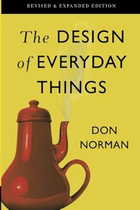The Design of Everyday Things
The first thing that struck me as unusual about the book was its formatting. Chapter headings were right-aligned, sub-chapter headings left-aligned with an indent, page numbers were on both sides, and so on. There seemed to be a lack of consistency. While it didn’t distract me from the content, it was a little off-putting at times. Am I just so accustomed to books formatted a certain way? I picked up a few others I own and noticed their formats were not identical either, though the majority had chapter headings on the left side of the page and there was consistency :-).
Having said that, I found the content fascinating. It explores a wide variety of products—from door knobs to computer software—with human behavior always at the center. It’s hard to summarize everything I enjoyed about the book, but here are a few highlights:
- The design of the scissor: When you look at a scissor, you instantly understand what it’s meant for, how to hold it, how to use it, and the constraints it imposes if held incorrectly. It’s a brilliant design.
- It’s not always human error or a lack of intelligence; it’s often a design flaw: Take elevator buttons, for example. We tend to assume the buttons would clearly indicate the action, but instead, they often confuse us about the direction.
- Older generations’ fear of new technology: I’ve noticed this fear often stems from an anxiety about making mistakes or feeling inadequate. This isn’t their fault but rather the fault of poor design that makes these products appear more complex than they are.
- The paradox of noise in automobiles: For years, we’ve worked to make cars quieter, but now, with electric vehicles, we have to add artificial noise to prevent accidents.
The book stresses that we should put usability and user experience in the forefront when designing objects. It should be self explanatory and the user should be able to use them correctly immediately.
Overall, a very good read.
© 2025 Sindhuja Cheema Enzinger. All Rights Reserved.

